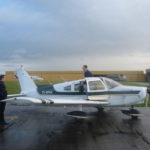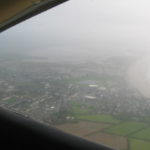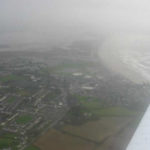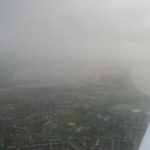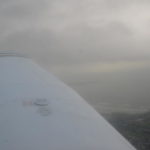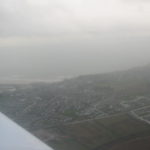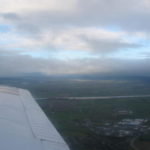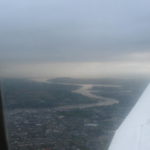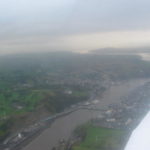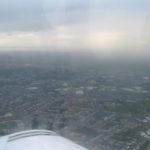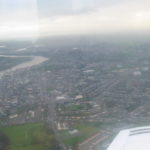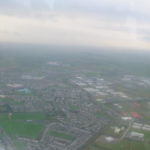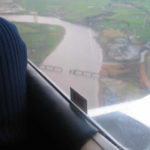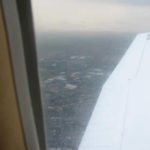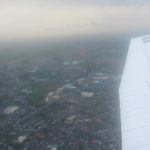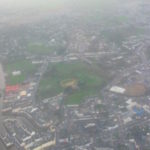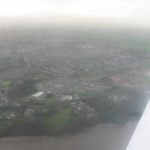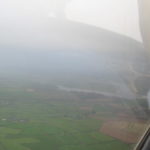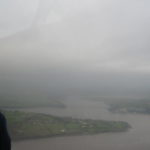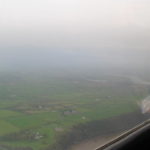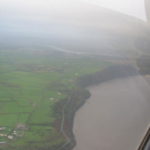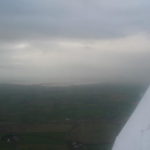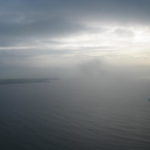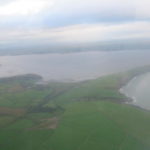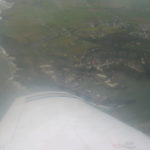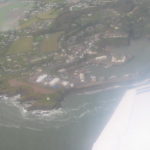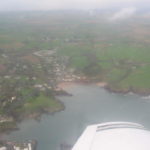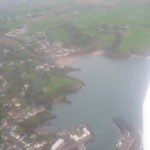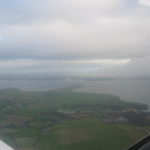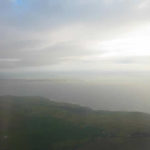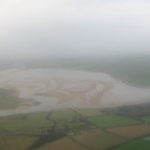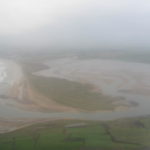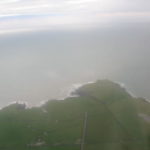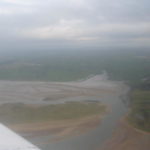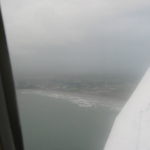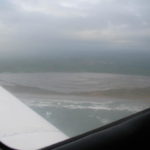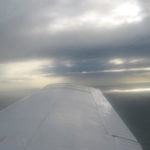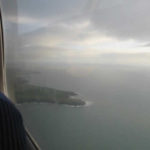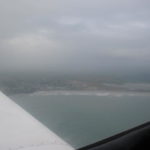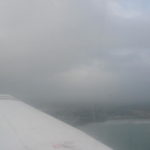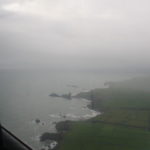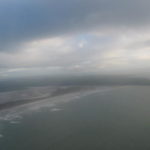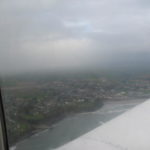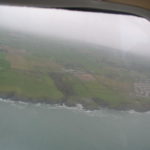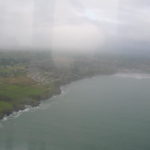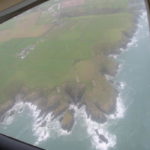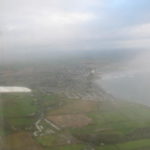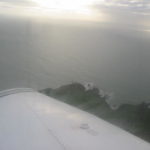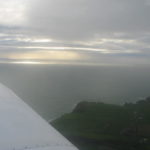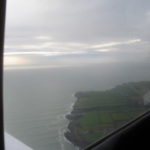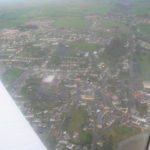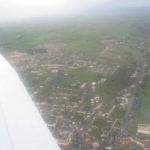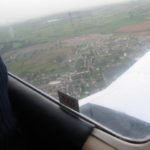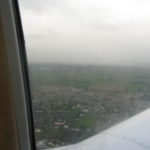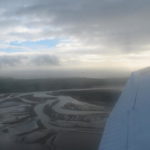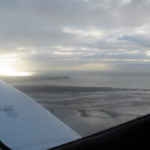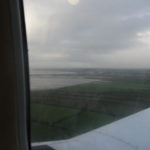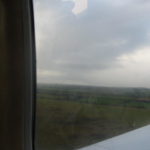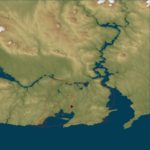I’m back in Ireland for Christmas. My home town is called Tramore, on the southeast coast of Ireland in Co. Waterford. Its a beautiful area, the town sits on a hill overlooking a 3 mile long sandy beach in front of a wide bay. However, the weather sucks, it has pretty much been misty and wet since I arrived. I was hoping to fly sometime over the holiday at Waterford Aero Club which operates out of the regional airport just 5 miles away from my home. I had setup a flight for last Tuesday, but it was scrubbed due to weather. Today however it looks a little brighter (not much) but at least VFR. I called the club early this morning and got a slot booked for 11:30am flying in a Piper Warrior. I’m bringing one of my brothers with me as a passenger/photographer and partly as a Christmas present.
We arrived a little early and found the club building, it doesn’t look promising from the outside just an industrial hanger sitting off the side of the runway. However, when we get inside it has a nice club room upstairs with a wall of windows overlooking the airport, it almost looks like a bar, comfortable seats and tables along the window and a counter (very like a bar) along the other wall, but not a drop of alcohol in sight. Brian Brown, the clubs instructor who was flying with us, had me sign some paper work to get a 1-day membership for 5 euros (almost exactly US$5), he said this would cover us with the clubs insurance. Then just told me to go out and pre-flight the little Warrior we could see parked on the ramp outside.
The pre-flight was different, there was a folder with a checklist in the plane but it really wasn’t that helpful. Almost by definition a checklist in written in shorthand as a reminder to do things you already know so this strange checklist didn’t really tell me enough to be useful. I reverted to the basics, checking the fuel levels, finding and checking the fuel sumps and making sure all the control surfaces moved the way they are supposed to. The Warrior is a low wing plane so its a pain crawling around under the wind trying to find the fuel sumps and pitot tube. Brian turned up shortly afterwards and we all climbed through the one right side door. Brian ran through the cockpit controls, basically the same instruments as a Cessna, but manual flaps operated by a big handle on the floor (like a car’s handbrake). The avionics were older than anything I’ve seen in the Tradewinds planes. The throttle and mixture control are levers rather than the push/pull type with a little toggle switch for carb heat. We worked through the interior checklists together, much easier with somebody to tell me what each item was and got the engine fired up and I taxied out a little ways from the hanger.
Brian thankfully took care of the radio work, frankly the tower communications and procedures are completely different from what I’m used to in San Jose. I brought a handheld radio home with me (my Christmas present to myself) and I’d been listing into the tower communications for the last week and a half. Even though the airspace for 10nm around the airport is called class C it is nothing like class C in the USA. The tower actually doesn’t seem to “control” the airspace for VFR aircraft, though they do issue instructions to IFR flights. You don’t hear “cleared to land”, it was usually “land at your discretion”. Apparently the tower doesn’t have radar, so everybody in the whole area reports their position to the tower and a fairly regular basis. There is no ATIS or AWOS, instead the tower gives you the weather on request. All that, and typically Irish very informal and laid back. It was not uncommon to hear stuff like “Hey Mick, will you want fuel?” from the tower to an inbound commercial flight, I guess they know all the pilots by name. Lastly, don’t ever complain that the US National Airspace System is complicated. It is a model of logic and reason compared to the patchwork quilt of different airspace types, terminal areas and rules in Europe. I bought a book on UK aviation regulations when I got here to familiarize myself with the differences between Ireland and the USA, in the end I gave up trying to make sense of the European system.
Back to the plane, Brian filed a flight plan with the tower (no Flight Service Stations here). A flight plan is required for every flight, event local stuff like this. I taxied out to the run-up area and we went through a run-up procedure essentially identical to the Skyhawk. Then out to the runway, again no clearance needed to taxi onto the runway, really like an uncontrolled field. The takeoff was good, though the airspeed indicator reads in MPH rather than KIAS so all the speeds (like rotation and Vy) were bigger numbers than I was used to. We climbed out to the southeast and then turned right to head towards Tramore climbing up to 1,500’. If you’re not familiar with the local area then the route we flew won’t make much sense, but here it is anyway.
I flew out across the Backstrand, directly towards the Metalman and circled a couple of times around it. The weather was cloudy with a broken base at about 2000’. Still we could see well down the coast as far as Dungarvan and over to Hookhead to the east. There was a big rain shower coming in from the west so we flew across the mouth of the bay past Brownstown Head over Dunmore East. I made a left turn over Dunmore and headed up the River Suir passing Woodstown, Passage East and Cheekpoint and followed the river to Waterford City. Then we turned left again and flew over Waterford Industrial Estate and passed to the West of Tramore again out to the coast around Annstown. Turning left we followed the coast back around the Metalman once more basically towards Waterford which actually put us on the left downwind leg for the airport. There was a fairly strong west wind blowing about 40 degrees across the runway so Brian said he would give me a hand on the crosswind landing, me being a fair weather California flyer and all. In the event, I turned base and then final and pretty much got lined up with the runway with a mix of side slip and crab. Before I even realized it I was in the flare and made a great landing all things considered with no help from Brian.
So flying over the town where I grew up was a very cool thing. It was expensive compared to flying in San Jose, about $140 for the hour on the Hobbs meter including the instructor charge. Considering the cost of living (and salaries) are about half of that in the Bay Area it must be a big financial burden to learn from scratch. Brian said it takes about a year to accumulate enough hours for a private pilot license in Ireland, the required hours are similar to the USA but weather keeps you grounded a lot of the time. He learned to fly in Colorado. Its easy to see why so many foreign students come to the USA to learn.

